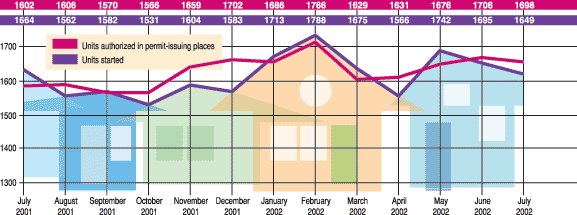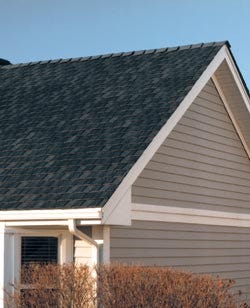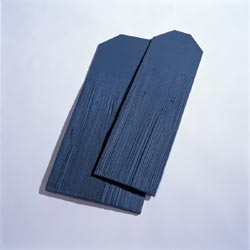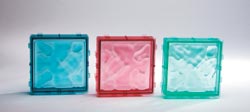Market Snapshot: Building & Construction 19966
September 26, 2002
|
Roofing tiles made to look like cedar are molded of EPDM and TPO. Seneca Cedar Shakes from EcoStar are said to be durable and lightweight, and come with molded-in instructions and nail placement markings. |
If there’s been one bright spot in the gloomy economy, it’s the construction industry. In almost every major city, construction sites continue to be part of the landscape. While the rest of the country fell into a recession in 2001, developers racked up an estimated $481 billion in new-project starts, according to F.W. Dodge, a McGraw-Hill Cos. unit that tracks the construction industry.
Yet it’s housing, and not commercial construction, that has carried the market (see graph, below). A glut of office and factory space nationwide resulting from the dot-com fallout and manufacturing downsizing slowed commercial construction, but housing is a different story. Housing represents about 45 percent of all new construction in the U.S., and F.W. Dodge predicts that housing starts for 2002 will hold steady.
There are some trends that are obvious: Sales of luxury homes have dropped drastically, and sales of moderately priced homes are picking up. There is a projected upswing in health care facility construction (thank the aging population for that), and schools, particularly colleges and universities, have increased their budgets to accommodate an impending influx of Generation Y students.
Plastics’ Role
If building and construction once held few applications for plastics, that all changed over the past decade. Many construction applications are extruded products such as vinyl window and door framing, and plastic lumber for decorative trim and patio/decking applications. What haven’t changed are builders’ attitudes toward anything new in their field.
Developing new products for the building and construction industry is tricky because builders are very risk averse, explains Robert Russell, general manager for SimRidge Technologies’ Tempe, AZ custom injection molding facility.
Russell, formerly of GE Plastics, was heavily involved in that company’s “Plastic House†and says he spent a lot of time understanding the building and construction industry. That background has given him an edge on a new program that SimRidge recently took on: molding “cedar shake†roofing shingles from a proprietary polymer compound for EcoStar, a division of Carlisle Syntec Inc., based in Vernon Hills, IL.
SimRidge purchased two large-tonnage presses—700 and 650 tons—in which to mold the Seneca brand roofing tiles. EcoStar, the company that developed the product, designed the Seneca Cedar Shake tiles to look like traditional cedar shakes. The tiles are molded of recycled materials that include rubber (EPDM) and plastic (TPO), which make the tiles durable and lightweight. They come in random widths of 6, 9, and 12 inches to create the traditional look of a wood shake roof, and nine colors to allow for creative architectural touches.
More importantly, the Seneca Cedar Shake tiles are applied like shake and come with molded-in instructions and markings for appropriate nail placement—a critical factor in winning acceptance of the product from the builder community. The shingles are shipped in bundles just like cedar shake shingles, also enhancing the builders’ comfort level with the product.
EcoStar also offers Majestic Slate, made from 100 percent recycled rubber and plastic, and like the Seneca product, it is available with a 50-year warranty, including a 100-mph wind warranty. The plastic/rubber roofing tiles offer long life, fire safety, and impact resistance. Additionally, there is less breakage than with actual slate or cedar shingles, and modifications to the tiles can be done onsite with a utility knife.
New privately owned housing units, U.S., thousands of units
(seasonally adjusted annual rate)
Source: U.S. Census Bureau
Windows Provide Light and Light Weight
Another example of an injection molded building product in which the construction industry has, until recently, shown minimal interest is the acrylic block window. Although the concept has been around for more than a decade, the product is only now receiving the credibility it deserves. A new, improved design tradenamed Crystal View, manufactured by Builders Accessories Inc. (Phoenix, AZ), has given the construction industry a long-lasting, viable product that solves many of the problems of traditional glass blocks.
Crystal View acrylic windows allow plenty of light to enter a room while preserving privacy. Traditionally, glass block windows were used to satisfy this need, but about 10 years ago a few companies began experimenting with acrylic blocks.
Builders Accessories’ marketing director, Erick Felsch, says Crystal View acrylic block windows offer advantages that far exceed glass windows and even other acrylic block windows. These blocks are approximately 75 percent lighter than glass, which means that the windows can be easily supported in almost any standard framing infrastructure. For example, a 4-by-4-ft glass block window weighs approximately 250 lb, where a 4-by-4-ft Crystal View acrylic block window weighs only 50 lb.
Additionally, instead of having to hire a separate laborer to lay the glass block one at a time, the Crystal View window comes prefabricated in a frame and ready to install just like a regular window. It’s also 35 percent more energy efficient because the acrylic conducts less energy than traditional glass block windows. The blocks incorporate an innovative “Breathing Method†technology molded in, which helps prevent cracking and possible seal failures due to temperature, humidity, and altitude changes. They’re available in traditional clear or colored wave pattern blocks, and a newly designed frosted version.
|
Window blocks are also switching media, like these Crystal View acrylic windows. They’re 75 percent lighter than glass. |
The blocks are molded at Fiesta Plastics (Tempe, AZ) in a dedicated press and subassembled by liquid welding the two halves together. Builders Accessories then assembles the blocks into standard or custom window sizes, fits the window into a vinyl or aluminum frame, and seals the unit with silicone grout.
What It Takes to Succeed
SimRidge’s Russell says that there are three factors needed for the success of a product, something particularly true of products for the building and construction industry. First, there is the product itself. “Anything that smacks of ‘different’ from what [builders] have done for the past 100 years is a tough sell,†says Russell. That’s why EcoStar’s roofing products look like and act like traditional products.
Kerston Russell, president of EcoStar, bought the rights to the product several years ago when the company that had them failed. He took the materials compound and designed the products to accommodate the building market. “I’m an architect by training, so the design of the product was more important to me than the actual compound of the material,†says Kerston Russell.
Secondly, there is the process. “The building and construction industry is a low-margin business in which efficiency is critical to producing any product used in that business,†says SimRidge’s Robert Russell.
Third, there is the channel. In the case of many new products, the strategy employed is one of push marketing, in which there is no recognized demand for the product. The product’s manufacturer must create demand in the marketplace. Robert Russell refers to this difficult strategy as “pushing a rope.â€
In the case of EcoStar, a small company invented the product. It was a great idea whose time had come. However, the process needed to be refined to make the product efficiently and establish a distribution channel, something the small company couldn’t do. However, a company like Carlisle Syntec could and did.
“It’s been an uphill battle but it’s finally coming on,†says Kerston Russell. “We tried to make it so the builders don’t have to change how they put it down. We’ve just improved the product and its look. Ask them to change too much and they’ll fight you. Ask them to change a little bit, and they’ll embrace it.â€
You May Also Like






